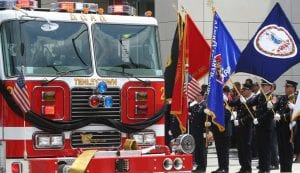Types of Firefighter Funerals
 When planning a firefighter funeral, how the hero has died will be taken into consideration. Generally, there are three types or levels of firefighter deaths resulting in a department funeral:
When planning a firefighter funeral, how the hero has died will be taken into consideration. Generally, there are three types or levels of firefighter deaths resulting in a department funeral:
- Line of duty death (LODD): the firefighter died while on duty or died after an incident that was the direct cause of the later death. Full military-style honors.
- Non-LODD for an active or uniformed firefighter. Department funeral with some military-style honors.
- Non-LODD for an inactive or affiliate member (non-uniformed, retired, honorary, spouse, or dependent). Whether these members are honored with a department funeral is up to department policy.
Alternately, the types of funerals can be classified as formal (full military-style honors and traditions), semi-formal (some traditions and honors), non-formal, and private. Even if the death was in the line of duty, the family can decide to have a semi-formal or non-formal service. If the family chooses a private service, the department can still hold a memorial.
Formal Firefighter Funeral with Full Honors
A funeral for a line of duty death generally presents the family with many options and traditions for honoring their loved one (Funeral Procedures for Firefighters, National Volunteer Fire Council, Second Edition):
- The use of apparatus
- Pallbearers
- A color guard (optional)
- A funeral detail composed of fire personnel in Class A uniforms
- Badge shrouds
- Bagpipers
- A bell service (“Last Alarm” or “Last Call”)
- A bugler
- Crossed ladders at the entrance to the cemetery
- A fire engine caisson
- An honor guard
- Station/vehicle bunting
We can’t overemphasize the importance of both determining and respecting the family’s wishes in regard to the firefighter funeral service. The Montgomery, NY, Fire Department offers the following questions to discuss with the family regarding the wake and funeral for a line of duty death:
- Do they want an honor guard at the wake?
- Do they need pallbearers? Who? How many?
- Will there be a church service? If so, where and what time?
- What cemetery will be used for burial?
- Do they need to use the firehouse or pavilion for refreshments after the wake or funeral?
- Will there be a procession to the place of interment, and what route will it take?
- Will apparatus be in the procession and/or used for carrying the casket, flowers, etc.?
- Do they want firefighters to escort the hearse (coffin) in the procession or upon entering the cemetery?
- Do they want bagpipes? Where will they play? Church, procession, cemetery?
- Do they want a “Last Call” and if so, where? Firehouse, cemetery?
The National Volunteer Fire Council suggests these additional topics to consider, depending on department procedures:
- Procession route, which may include a drive or walk by the deceased’s fire station or home, or other special considerations
- Providing a static display of apparatus if requested and appropriate on the procession route
- Providing crossed ladders or aerial equipment if requested and appropriate at the cemetery entrance
Other topics to discuss would be whether there will be burial or cremation; whether they need help with housing for out-of-town relatives, child care, transportation, or a post-service luncheon; who they would like to deliver the eulogy; whether they want to designate a cause or charity in lieu of flowers; and other routine questions asked of any family suffering a loss.
Semi-Formal Firefighter Funeral with Honors
In the case of an off-duty death of an active department member or affiliate member, the following honors may be given:
- Pallbearers
- Color guard (optional)
- A funeral detail composed of fire personnel in Class A uniforms
- Badge shrouds
- A bell service
- An honor guard
- Station/vehicle bunting
Non-Formal Firefighter Funeral with Honors
If the deceased was a non-firefighting, affiliated, or retired department member or the immediate family of a firefighter, non-formal honors may be given:
- A funeral detail of fire personnel in Class A uniforms
- Badge shrouds
- A bell service
- An honor guard
- Station bunting
Again, these options are dependent on the wishes of the deceased, the preferences of the family, and the resources of the affected fire department. The department should be absolutely certain of its ability to provide a particular tradition or honor before it offers it to the family. For example, if the family wants a color guard, but the department is in a small community and doesn’t have its own color guard, it must confirm the availability of a color guard through another department or the American Legion or VFW before promising one for the funeral.
Sample Order of Events
For a formal, full-honors funeral (from the Utah State Fire Chiefs Association Firefighter Line-of-Duty Death Guidelines, 2006).
- Invocation
- Prayer
- Opening remarks/greetings
- Special music
- Scripture reading/clergy remarks
- Speakers
- Mayor
- Local elected official from district
- State or Federal officials
- Family representative(s)
- Union representative
- Department representative’s friends
- Eulogy – Chief
- Special music
- Presentations
- Closing remarks/prayer
- Last Alarm ceremony
- Bagpipes
- Dismissal instructions

